Practice the AP 10th Class Biology Bits with Answers Chapter 1 Nutrition on a regular basis so that you can attempt exams with utmost confidence.
AP State Syllabus 10th Class Biology Bits 1st Lesson Nutrition with Answers
Concept – 1 : Introduction – Autotrophic Nutrition
Question 1.
Fill the equation correctly.

A) CO2,C2H5OH,6O2
B) 6 CO2,12 H2O, C6 H12 06
C) 6 CO2, C6 H12O6 , O2
D) 6 CO2, C6 H12O6,6 O2
Answer:
D) 6 CO2, C6 H12O6,6 O2
Question 2.
Van Neil worked on …………………..
A) Purple sulphur bacteria
B) Hydrilla
C) Chloroplast
D) Paramoecium
Answer:
A) Purple sulphur bacteria
![]()
Question 3.
Famous photosynthesis equation was proposed by which scientist ?
A) Arnon
B) Hill
C) C . B . Van Neil
D) Jackson
Answer:
C) C . B . Van Neil
Question 4.
In autotrophs the energy is stored as ………………….
A) Fats
B) Proteins
C) Glycogen
D) Carbohydrates
Answer:
D) Carbohydrates
Question 5.
Who opined when each molecule of carbohydrate is formed, one molecule of water and one molecule of oxygen are also produced during photosynthesis?
A) C.B. Van Neil
B) Von Sachs
C) Caventou
D) Pelletier
Answer:
A) C.B. Van Neil
Question 6.
Instead of H2O purple sulphur bacteria use …………….. as a starting material.
A) H2S
B) Hydrogen
C) Chlorine gas
D) CO2
Answer:
A) H2S
Question 7.
‘X’ is photosynthetic bacteria which uses hydrogen sulphide instead of water. Which element is released during the photosynthesis of this bacteria ?
A) O2
B) Sulphur
C) H2
D) All of the above
Answer:
B) Sulphur
Question 8.
Which part of the plant takes in carbon dioxide from the air for photosynthesis?
A) Root hair
B) Stomata
C) Leaf veins
D) Sepals
Answer:
B) Stomata
Question 9.
One of the following is not useful for the autotrophs during synthesis of chemical substances by utilising light energy.
A) Oxygen
B) Carbon dioxide
C) Stomata
D) Water
Answer:
A) Oxygen
![]()
Question 10.
From which of the following, the oxygen is released in plants during photosynthesis?
A) Glucose
B) Water
C) CO2
D) Chlorophyll
Answer:
B) Water
Question 11.
One of the following did not reveal that growth of plant is influenced by photosynthesis?
A) Van Helmont
B) Ingenhousz
C) Engleman
D) Mohl
Answer:
A) Van Helmont
Question 12.
Which of the following does not occur in photosynthesis ?
A) Conversion of light energy to chemical energy
B) Reduction of carbon dioxide to carbohydrates
C) Oxidation of carbon to carbon dioxide
D) Chlorophyll absorbs photons
Answer:
C) Oxidation of carbon to carbon dioxide
Question 13.
Find the missing product in the equation.

A) CO2
B) H2O
C) C6H12O6
D) 6 SO2
Answer:
B) H2O
Question 14.
Reason for calling Hill reaction as light reaction
A) Break down of water molecule by light
B) Break down of chlorophyll atom by light
C) Conversion of Hydrogen ions of water tp Hydroxyl ions
D) Water is formed by combination of Hydrogen and Hydroxyl ions
Answer:
A) Break down of water molecule by light
Question 15.
Autotrophic organisms:
A) depend on other organisms for food
B) hunt for the food
C) synthesize their own food
D) cannot synthesize their food
Answer:
C) synthesize their own food
Question 16.
Find out the false statement from the following:
A) Energy is required for metabolic activities
B) Organisms grow along with time
C) Transportation of molecules do not occur in cells
D) Organisms construct their body on their own
Answer:
C) Transportation of molecules do not occur in cells
![]()
Question 17.
The proper order of conducting experiment to test the starch in leaves.
1) Selection of a potted plant.
2) Pouring iodine drops on the leaf that is kept in petri dish.
3) Taking methylated spirit into the test tube.
4) Heating the leaf in test tube for removal of chlorophyll.
A) 4, 3, 1, 2
B) 4, 1, 3, 2
C) 1, 3, 2, 4
D) 1, 3, 4, 2
Answer:
D) 1, 3, 4, 2
Question 18.
………… detected the point of maximum rate of photosynthesis.
A) Engelman
B) Eastman
C) Arnon
D) Neils Bohr
Answer:
A) Engelman
Question 19.
We use ganji (boiled rice water) for conducting action of ……………….. in the digestive system.
A) pepsin
B) mucin
C) saliva
D) lipase
Answer:
C) saliva
Question 20.
To test for the presence of carbohydrates in whedt flour the following are mixed.
A) First saliva next iodine
B) First saliva next xyline
C) First iodine next saliva
D) First xyline next iodine
Answer:
C) First iodine next saliva
Question 21
No oxygen is liberated in purple sulphur bacteria during photosynthesis. This is
because they use:
A) H2O as starting material
B) H2S as starting material
C) CO2 as starting material
D) Photosynthesis is a chemical process
Answer:
B) H2S as starting material
Question 22.
The following picture depicts

A) Starch test
B) Protein test
C) Test for fats
D) Test for oils
Answer:
A) Starch test
Concept – 2 : Factors Essential for photosynthesis
Question 23.
Why we use KOH in a bottle in the experiment to iknow CO2 is necessary for photosynthesis?
A) To absorb chlorophyll in leaves
B) To absorb air in bottle
C) To absorb C02 in bottle
D) To absorb water vapour in the bottle
Answer:
C) To absorb CO2 in bottle
![]()
Question 24.
a : Chloroplasts convert simple inorganic substances into complex organic compounds.
b : Light energy is required for synthesis of carbohydrates.
A) Both a and b are true
B) a is correct, b is wrong
C) b is correct, a is wrong
D) Both a and b are wrong
Answer:
A) Both a and b are true
Question 25.
In Mohl’s half-leaf, experiment, which part becomes bluish black for starch test?
A) Total leaf
B) Leaf part in the bottle
C) Leaf part outside the bottle
D) Venation of the leaf
Answer:
C) Leaf part outside the bottle
Question 26.
The solution, which is useful to decolorise a leaf.
A) Water
B) Iodine
C) KOH solution
D) Alcohol
Answer:
D) Alcohol
Question 27.
A plant is kept in dark cupboard for about forty eight hours before conducting any experiment on photosynthesis in order to :
A) remove chlorophyll from leaves
B) remove starch from leaves
C) ensure that no photosynthesis occurred
D) ensure that leaves are free from the starch.
Answer:
B) remove starch from leaves
Question 28.
What chemical is used to know the presence of starch in leaves?
A) Methylated spirit
B) Iodine
C) Methylated spirit, Iodine
D) Methylene blue
Answer:
B) Iodine
Question 29.
Mohl’s half leaf experiment shows ………………. is essential for photosynthesis.
A) O2
B) CO2
C) N2
D) Mg
Answer:
B) CO2
Question 30.
To test the importance of CO2 Mohl used……………… solution.
A) O2
B)COOH
C) K2SO4
D) KOH
Answer:
D) KOH
![]()
Question 31.
In Mohl’s half leaf experiment, the part of the leaf inside the flask does not become blue- black after adding iodine drops. It is because :
A) starch formation does not take place in that part
B) CO2 is absent inside the flask
C) light entering into the flask has more intensity
D) both A and B
Answer:
D) both A and B
Question 32.
 Given leaf is tested through Mohl’s experiment. The dark coloured part shows the presence of ……………….
Given leaf is tested through Mohl’s experiment. The dark coloured part shows the presence of ……………….
A) CO2
B) KOH
C) Starch
D) Sugar
Answer:
C) Starch
Question 33.
Sneha wants to know one of the factors of photosynthesis. She arranged total apparatus as shown in figure to conduct the experiment. This shows ………………….
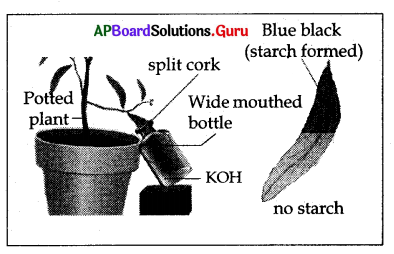
A) Light is essential for photosynthesis.
B) CO2 is essential for photosynthesis.
C) O2 is released during photosynthesis.
D) Chloroplasts are essential for photosynthesis.
Answer:
B) CO2 is essential for photosynthesis.
Concept – 3 : Light and Photosynthesis
Question 34.
The scientist who discovered that photosynthesis occurs only in the green parts of the plants
A) Engelman
B) Ingenhousz
C) Robert Hill
D) Kelvin
Answer:
B) Ingenhousz
Question 35.
The extract obtained by Pelletier and Caventou is ……………………
A) Colour pigments
B) Chlorophyll
C) Xanthophyll
D) Keratine
Answer:
B) Chlorophyll
Question 36.
Energy change takes place in photosynthesis …………………
A) Conversion of light energy to heat energy
B) Conversion of light energy to chemical energy
C) Conversion of light energy to electrical energy
D) Conversion of heat energy to chemical energy
Answer:
B) Conversion of light energy to chemical energy
Question 37.
The gas released by hydrilla twigs is …………………. . It burns the incense sticks with
glowing flames.
A) O2
B) CO2
C) CO
D) O3
Answer:
A) O2
![]()
Question 38.
Identify the right sequence of events of Hydrilla experiment.
1) Invert the funnel in the beaker of water.
2) Insert Hydrilla plant twigs in the funnel.
3) Insert the test tube filled with water over the funnel.
4) Fill water in the beaker.
A) 4, 2, 1, 3
B) 1, 2, 3, 4
C) 2, 1, 4, 3
D) 3, 4, 1, 2
Answer:
C) 2, 1, 4, 3
Question 39.
The figure below represents an experimental set up to study a physiological process in plants. Which of the following is being studied ?
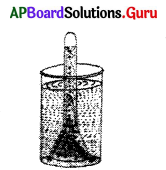
A) Excretion
B) Respiration
C) Photosynthesis
D) Transportation
Answer:
C) Photosynthesis
Question 40.
 The picture of leaf shows ………………. experiment of photosynthesis.
The picture of leaf shows ………………. experiment of photosynthesis.
A) Mohl’s
B) Light screen
C) KOH
D) Hydrilla plant
Answer:
B) Light screen
Question 41.
Observe the picture. If iodine is used on the leaf ………………….
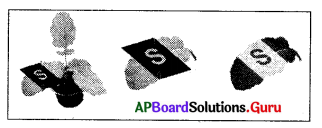
A) formation of deep blue colour at the non-light falling region.
B) formation of deep blue colour at the light falling region.
C) formation of deep blue colour on both light falling and non-light falling regions.
D) no colour formation on both regions.
Answer:
B) formation of deep blue colour at the light falling region.
Question 42.
 The covered portion did not change into blue because ………………..
The covered portion did not change into blue because ………………..
A) it does not receive CO2
B) it does not receive water
C) it does not receive light
D) it does not have chlorophyll
Answer:
C) it does not receive light
Question 43.
The figure given here is for performing an experiment on photosynthesis. What do you conclude from this experiment?

A) It proves that chloroplast is necessary for the manufacture of starch.
B) It proves that water is .necessary for the manufacture of starch.
C) It proves that carbon dioxide is necessary for the manufacture of starch
D) It proves that light is necessary for the manufacture of starch.
Answer:
D) It proves that light is necessary for the manufacture of starch.
Concept – 4 : Chlorophyll and Photosynthesis
Question 44.
Element present in Chlorophyll:
A) Magnesium
B) Ferrous
C) Manganese
D) Calcium
Answer:
A) Magnesium
![]()
Question 45.
The scientists who discovered chlorophyll are…………………
A) Joseph Priestley and Gregor Mendel
B) Lavoisier and Pelln
C) C .B . Van Neil and Julius Von Sachs
D) Pelletier and Caventou
Answer:
D) Pelletier and Caventou
Question 46.
Which of the following materials is /are synthesized by plants ?
A) Starch
B) Cellulose
C) Lipid
D) All
Answer:
D) All
Question 47.
The scientist who observed that chlorophyll in plants is not spread throughout the entire cell ………………
A) Van Neil
B) Van Dammy
C) Von Sachs
D) Von Rose
Answer:
C) Von Sachs
Question 48.
Number of chloroplasts in ground tissue of cell are……………………
A) 30 – 190
B) 40 – 100
C) 20 – 30
D) 40 – 720
Answer:
B) 40 – 100
Question 49.
Need of green chlorophyll pigmented molecules in leaves is
A) break down of water molecule into Hydrogen and Oxygen
B) to release green light
C) to trap solar energy
D) to trap electric energy
Answer:
C) to trap solar energy
Question 50.
The closing and opening of stomata depends on ………………
A) Oxygen
B) Water in guard cells
C) Temperature
D) Concentration of CO2
Answer:
B) Water in guard cells
Question 51.
Photosynthesis takes place in chlorophylls and produce glucose and carbohydrates.
What will happen if chlorophyll is absent ?
A) Production of Carbohydrates
B) Plant dies
C) Plant grows more
D) All
Answer:
B) Plant dies
![]()
Question 52.
These are the end products, of photosynthesis:
A) carbon dioxide, water, sucrose
B) glucose, water and oxygen
C) glucose, carbon dioxide, air
D) sucrose, water and oxygen
Answer:
B) glucose, water and oxygen
Question 53.
Light reactions are different from dark reactions in such a way that :
A) they are light independent
B) they occur in stroma of chloroplast
C) they occur in grana of chloroplast
D) they do not facilitate photolysis event
Answer:
C) they occur in grana of chloroplast
Question 54.
ATP and NADPH are :
A) reactants of light reactions
B) end products of light reactions
C) intermediate products of light reactions
D) precursors for light reactions
Answer:
B) end products of light reactions
Question 55.
In plants, exchange of gases takes place through:
A) Stomata
B) Palisade tissue
C) Spongy tissue
D) Midrib
Answer:
A) Stomata
Question 56.
How many pigment molecules are grouped as light harvesting complex or photosynthetic unit in each granum ?
A) 150 to 200
B) 250 to 300
C) 250 to 400
D) 350 to 500
Answer:
C) 250 to 400
Question 57.
If chloropyll is absent in leaves, plants cannot synthesize ………………..
A) Starch
B) Glucose
C) A & B
D) Cellulose
Answer:
C) A & B
Question 58.
The important factors of photosynthesis are
A) light, CO2, chlorophyll and temperature
B) light, chlorophyll, water and temperature
C) light, CO2, water and chlorophyll
D) water, chlorophyll, temperature and CO2
Answer:
C) light, CO2, water and chlorophyll
![]()
Question 59.
Chloroplasts present in large numbers in the cells (around 40 – 100) of plant tissue like the :
A) stomatal guard cells
B) ground tissue
C) both A and B
D) none of these
Answer:
C) both A and B
Question 60.
i) Light energy is converted into chemical energy.
ii) Photolysis of water,
iii) Reduction of CO2 and formation of glucose.
Where do all the above mentioned reactions occur?
A) Mitochondria
B) Ribosomes
C) Chloroplast
D) Lysosomes
Answer:
C) Chloroplast
Question 61.
Ram has forgot to label the part P. Identify it from the following.

A) Stomata
B) Chloroplast
C) Mesophyll
D) Starch grain
Answer:
A) Stomata
Question 62.
Below figure is a part of the epidermis of the leaf. What is the name of P ?
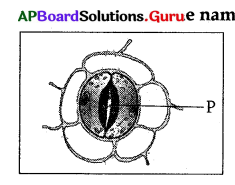
A) Cell
B) Spongy cell
C) Xylem cell
D) Guard cell
Answer:
D) Guard cell
Question 63.
This is the picture of chloroplast. Identify the part in which light reaction takes place.
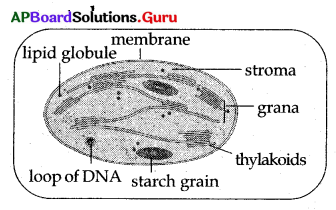
A) Stroma
B) Grana
C) Starch grain
D) Lipid globule
Answer:
B) Grana
Question 64.
Parts 1, 2 and 3 in the below given diagram indicate :
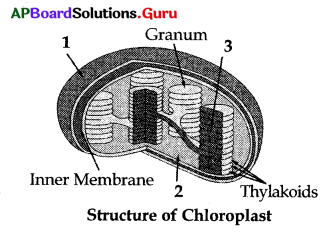
A) 1 – Outer membrane, 2 – Stroma, 3 – Grana
B) 1 – Grana, 2 – Stroma, 3 – Outer membrane
C) 1 – Stroma, 3 – Grana, 2 – Outer membrane
D) 1 – Stroma, 2 – Grana, 3 – Outer membrane
Answer:
A) 1 – Outer membrane, 2 – Stroma, 3 – Grana
Question 65.
1. Chlorophyll is similar to the haemoglobin of blood.
2. Haemoglobin has iron while chlorophyll has magnesium.
A) 1 is correct, 2 is wrong
B) 1 is wrong, 2 is correct
C) 1, 2 both are correct
D) 1, 2 both are wrong
Answer:
C) 1, 2 both are correct
Concept – 5 : Mechanism of Photosynthesis
Question 66.
End products of light dependent reaction is/are
A) C6H12O6
B) CO2
C) O2, ATP, NADPH
D) H2O
Answer:
C) O2, ATP, NADPH
![]()
Question 67.
This shows remarkable effect on photosynthesis:
A) Temperature
B) Humidity
C) Intensity of light
D) All of these
Answer:
C) Intensity of light
Question 68.
The end product of dark reaction is ……………………
A) PGA
B) CO2
C) Ribulose biphosphate
D) C6H12O6
Answer:
D) C6H12O6
Question 69.
ATP, NADPH2 are utilized in …………………
A) light reaction
B) excretion
C) dark reaction
D) respiration
Answer:
C) dark reaction
Question 70.
The rate of photosynthesis is NOT affected by this factor
A) Light intensity
B) Humidity
C) Temperature
D) Carbon dioxide concentration
Answer:
B) Humidity
Question 71.
 belongs to …………………….
belongs to …………………….
A) Fermentation
B) Dark phase
C) Hill’s reaction
D) Mold’s half leaf experiment
Answer:
C) Hill’s reaction
Question 72.
Which of these are required for autotrophic nutrition ?
A) Water, CO2
B) Chlorophyll
C) Sunlight
D) All
Answer:
D) All
Question 73.
This process doesn’t take place, if a plant is kept in dark room.
A) Respiration
B) Reproduction
C) Photosynthesis
D) Water transportation
Answer:
C) Photosynthesis
![]()
Question 74.
Site of light reaction
A) Grana of chloroplasts
B) Stroma of chloroplasts
C) Mitochondria
D) Golgi complex
Answer:
A) Grana of chloroplasts
Question 75.
How are H+ ions obtained in the given reaction ?
NADP + H+ → NADPH
A) Through dark reaction
B) Through light reaction
C) Through sunlight
D) Through rain
Answer:
B) Through light reaction
Question 76.
Assimilatory powers of light reaction …………………..
A) ATP, NADPH
B) H2O,O
C) CO2, ATP
D) CO2, NADPH
Answer:
A) ATP, NADPH
Question 77.
Correct order of the products that are synthesised by plants.
A) Glucose, starch, cellulose
B) Glucose, proteins, lipids, starch, cellulose
C) Proteins, lipids, cellulose, starch, glucose
D) Glucose, vitamins, lipids and alkaloids
Answer:
A) Glucose, starch, cellulose
Question 78.
Photosynthesis process determines the production of carbohydrates but not
A) Carbohydrates are intermediate products in photosynthesis
B) Glucose which is formed in photosynthesis immediately converted to carbohydrates
C) Carbohydrates dissolve in water
D) Glucose is not tested.
Answer:
B) Glucose which is formed in photosynthesis immediately converted to carbohydrates
Question 79.
The special intermediate compound of dark reaction:
A) RUBP
B) Glucose
C) Citric acid
D) Starch
Answer:
A) RUBP
Question 80.
What happens, if green plants are not there on earth ?
A) Living organisms will not get O2
B) Living organisms will not get CO2
C) Living organisms will not get N2
D) All the above
Answer:
A) Living organisms will not get O2
![]()
Question 81.
The important factors of photosynthesis are ……………..
A) Light, CO2, Chlorophyll, Temperature
B) Light, Water, Chlorophyll, Temperature
C) Light, Temperature, Chlorophyll, CO2
D) Light, Water, Chlorophyll, CO2
Answer:
D) Light, Water, Chlorophyll, CO2
Concept – 6 : Heterotrophic Nutrition
Question 82.
Cuscuta plant absorbs food through
A) Haustoria
B) Stem
C) Root
D) Flower
Answer:
A) Haustoria
Question 83.
Example for saprophyte
A) Mushroom
B) Louse
C) Paramoecium
D) Owl
Answer:
A) Mushroom
Question 84.
Example for with highly branched digestive system.
A) Jelly fish
B) Ascaris
C) Fasciola hepatrica
D) Star fish
Answer:
C) Fasciola hepatrica
Question 85.
The Cuscuta belongs to this family.
A) Malvaceae
B) Solanaceae
C) Convolvulaceae
D) Fabaceae
Answer:
C) Convolvulaceae
Question 86.
Amoeba takes the food through……………………
A) Nucleus
B) Pseudopodia
C) Vacuole
D) Cytoplasm
Answer:
B) Pseudopodia
Question 87.
In single celled animals the food is taken by
A) the entire body surface
B) mouth
C) teeth
D) vacuoles
Answer:
A) the entire body surface
![]()
Question 88.
Which of the following organisms takes food by parasitic nutrition ?
A) Yeast
B) Mushroom
C) Cuscuta
D) Amoeba
Answer:
C) Cuscuta
Question 89.
The site of ingestion of food in paramoecium
A) Pseudopodia
B) Flagella
C) Cytostome
D) Nucleus
Answer:
C) Cytostome
Question 90.
The mode of food intake in Amoeba is …………………
A) Dialysis
B) Cytokinesis
C) Phagocytosis
D) Amoebiosis
Answer:
C) Phagocytosis
Question 91.
Pick up the correct option for “Dodder.”
1) Genus Cuscuta
2) It is leafless
3) Twining plant
4) Microscopic
5) Parasitic in nature
6) Family is Convolvulaceae
A) 1, 2, 3, 5, 6
B) 1, 3, 4, 5, 6
C) 1, 3, 4, 5
D) 1, 2, 3, 4, 5, 6
Answer:
A) 1, 2, 3, 5, 6
Question 92.
Example for parasite :
A) Cuscuta
B) Lice
C) Leech
D) All
Answer:
D) All
Question 93.
Example for parastic plant
A) Cuscuta
B) Hibiscus
C) Bitter gourd
D) Jasmine
Answer:
A) Cuscuta
Question 94.
Water is drawn through the haustoria from the host plant’s
A) xylem
B) leaves
C) phloem
D) nodules
Answer:
A) xylem
![]()
Question 95.
The dodder contains ……………….. amount of chlorophyll.
A) less
B) more
C) moderate
D) zero
Answer:
A) less
Question 96.
Food movement in paramoecium is facilitated by
A) cilia
B) cytostome
C) flagella
D) pseudopodia
Answer:
A) cilia
Question 97.
In which colour do you find the slender, string like stems of the Dodder?
A) Yellow
B) Orange
C) Pink
D) All the above
Answer:
D) All the above
Question 98.
Animals cannot synthesize the following.
(i) Carbohydrates
(ii) Cellulose
(iii) Lipid
(iv) Protein
A) i only
B) i, ii only
C) iii only
D) iii, iv only
Answer:
B) i, ii only
Question 99.
When ‘Dodder’ plant is fully grown it obtains food through part (ii) only after development of part (i). What are (i) and (ii)?
A) (i) leaves (ii) haustoria
B) (i) haustoria (ii) anchoring roots
C) (i) anchoring roots (ii) haustoria
D) (i) leaves (ii) anchoring roots Observe the diagram
Answer:
C) (i) anchoring roots (ii) haustoria
Question 100.
Observe the diagram  …………………… is occurring in ampeba.
…………………… is occurring in ampeba.
A) Nutrition
B) Elimination
C) Excretion
D) A or B
Answer:
A) Nutrition
Question 101.
The dodder seed germinates forming
A) anchoring root
B) slender stem
C) haustoria
D) hanging leaves
Answer:
A) anchoring root
![]()
Question 102.
Root like structures in cuscuta that penetrate the tissue of a host plant to absorb food is ………………
A) Dodder
B) Haustoria
C) Legume roots
D) Aerial roots
Answer:
B) Haustoria
Concept – 7 : Nutrition in Human Beings
Question 103.
The digestive juice without enzyme is
A) Gastric juice
B) Pancreatic juice
C) Intestinal juice
D) Bile juice
Answer:
D) Bile juice
Question 104.
Emulsification of the fats in human body occurs in …………………
A) small intestine
B) liver
C) pancreas
D) stomach
Answer:
B) liver
Question 105.
Enzyme that helps in fat metabolism
A) Trypsin
B) Lipase
C) Ptyaline
D) Pepsin
Answer:
B) Lipase
Question 106.
Identify the correct order of digestion process.
A) Digestion → ingestion → absorption → defecation
B) Ingestion → absorption → digestion → defecation
C) Ingestion → digestion → absorption → defecation
D) Ingestion → defecation → digestion → absorption
Answer:
C) Ingestion → digestion → absorption → defecation
Question 107.
The surface area in the small intestine is increased due to ………………
A) Villi
B) Mucous glands
C) Cilia
D) Cristae
Answer:
A) Villi
![]()
Question 108.
In man, where does the digestive process end ?
A) Oesophagus
B) Small intestine
C) Stomach
D) Large intestine
Answer:
D) Large intestine
Question 109.
The part in which the digestive process starts in man ……………………
A) Stomach
B) Oesophagus
C) Mouth
D) Small intestine
Answer:
C) Mouth
Question 110.
In alimentary canal, where do the proteins get digested at first ?
A) Small intestine
B) Oesophagus
C) Mouth
D) Stomach
Answer:
D) Stomach
Question 111.
Which of the following helps in protecting the walls of stomach from Hydrochloric acid ?
A) Pepsin
B) Mucus
C) Saliva
D) Bile Juice
Answer:
B) Mucus
Question 112.
The part of food pipe which collects bile juice from liver is …………………..
A) Oesophagus
B) Small intestine
C) Duodenum
D) Large intestine
Answer:
C) Duodenum
Question 113.
The following processes do not occur due to the lack of secretion of bile juice.
i) Splitting of proteins
ii) Formation of glucose
iil) Emulsification of fats
iv) Formation of glycerine
A) i, ii
B) ii only
C) ii, iii, iv
D) iii only
Answer:
D) iii only
Question 114.
Find out the ascending order for digestion of food in the alimentary canal.
i) Mastication
ii) Contraction of muscles
iii) Peristaltic movements
iv) Emulsification of fats
A) i, ii, iii, iv
B) i, iii, ii, iv
C) i, iv, iii, ii
D) iv, iii, ii, i
Answer:
A) i, ii, iii, iv
![]()
Question 115.
Emulsification in digestive system is due to the presence of
A) Saliva
B) Gastric juice
C) Pepsin
D) Bile juice
Answer:
D) Bile juice
Question 116.
The length of small intestine in human being is ………………
A) 4.5 m
B) 1.5 m
C) 3.5 m
D) 6.5 m
Answer:
D) 6.5 m
Question 117.
Which of the following can be digested by the enzymes present in pancreatic juice?
A) Proteins and carbohydrates only
B) Proteins and fats only
C) Fats and carbohydrates only
D) Proteins, fats and carbohydrates
Answer:
D) Proteins, fats and carbohydrates
Question 118.
The enzyme which mixes up with food in alimentary canal at first is ………………..
A) Pepsin
B) Trypsin
C) Salivary Amylase
D) Glycogen
Answer:
C) Salivary Amylase
Question 119.
Acid present in Gastric juice
A) Sulphuric Acid
B) Hydrochloric Acid
C) Nitric acid
D) Phosphoric acid
Answer:
B) Hydrochloric Acid
Question 120.
The process of convertingfats into small globule like forms by the bile juice secreted from liver is :
A) mastication
B) emulsification
C) desertification
D) lipogenesis
Answer:
B) emulsification
Question 121.
Which of the following enzymes is secreted into stomach ?
A) Sucrase
B) Lipase
C) Trypsin
D) Pepsin
Answer:
D) Pepsin
Question 122.
The function of sphincter is to :
A) prevent materials from moving backward
B) allow materials to move from one segment to another
C) regulate the opening of the passage
D) all the above
Answer:
D) all the above
![]()
Question 123.
Digestion of carbohydrates does not takes place in stomach. This is due to:
A) their hardness
B) the absence of enzymes that act on them
C) presence of more acids
D) the inactivation of pepsin
Answer:
B) the absence of enzymes that act on them
Question 124.
Complete digestion of food molecules occurs in :
A) stomach
B) small intestine
C) large intestine
D) buccal cavity
Answer:
B) small intestine
Question 125.
The first enzyme that mixes with food in the digestive system is :
A) Pepsin
B) Ptyalin
C) Lipase
D) Trypsin
Answer:
B) Ptyalin
Question 126.
Food in the form of a soft slimy substance where some proteins and carbohydrates have already been broken down is called :
A) chyme
B) bile
C) succus entericus
D) bolus
Answer:
A) chyme
Question 127.
Ramu is suffering from vomitings and nausea. What happened to him ?
A) Suffering from indigestion
B) Liver loses capacity of digestion due to excess intake of fats
C) Liver becomes weak due to less fats
D) Ramu consumes raw leafy secretions
Answer:
B) Liver loses capacity of digestion due to excess intake of fats
Question 128.
If salivary amylase is absent, which of the following process gets affected badly?
A) Conversion of proteins to amino acids.
B) Conversion of carbohydrates to glucose.
C) Conversion of fats to fatty acids.
D) Formation of ulcers.
Answer:
B) Conversion of carbohydrates to glucose.
![]()
Question 129.
a : Bile juice doesn’t have enzymes.
b : Emulsification of fats is done by bile juice.
A) Both a and b are true
B) a true, b false
C) b true, a false
D) a, b both are false
Answer:
A) Both a and b are true
Question 130.
If this is absent in saliva, swallowing food Will be difficult
A) Amylase
B) Pepsin
C) Protein
D) Mucin
Answer:
D) Mucin
Question 131.
Find out wrong pair.
A) Saliva – Ptyalin
B) Pancreatic juice – Amylase
C) Gastric juice – Lipase
D) Intestinal juice – Peptidase
Answer:
C) Gastric juice – Lipase
Question 132.
Excessive intake of fats causes
A) Nausea
B) Vomiting
C) Digestion
D) A and B
Answer:
D) A and B
Question 133.
Find out wrong pair.
A) Saliva – Ptyalin
B) Pancreatic juice – Amylase
C) Gastric juice – Lipase
D) Intestinal juice – Peptidase
Answer:
C) Gastric juice – Lipase
Question 134.
Which of the following is the correct statement regarding bile ?
A) It is secreted by bile duct and stored in liver.
B) It is secreted by gall bladder and stored in liver.
C) It is secreted by liver and stored in bile duct.
D) It is secreted by liver and stored in gall bladder.
Answer:
D) It is secreted by liver and stored in gall bladder.
Question 135.
These people suffer from intestinal ulcers.
(i) Restless employees
(ii) Political leaders
(iii) Overtime TV viewers
(iv) Time to time meals consumers
A) i only
B) iii only
C) i, ii
D) iii, iv
Answer:
A) i only
Question 136.
Reasons for formation of ulcers in stomach
A) Improper food intake
B) Stress and strain
C) Bacteria
D) All
Answer:
D) All
![]()
Question 137.
One of the following is not a good habit related to digestion
A) Having balanced meals
B) Taking more junk foods
C) Thoroughly masticating the food
D) Drinking more water
Answer:
B) Taking more junk foods
Question 138.
These play a key role in nutrition
A) Assimilation
B) Expulsion of wastes
C) Regular exercises
D) A and B
Answer:
D) A and B
Question 139.
Thoroughly masticating food enables easy ………………
A) constipation
B) digestion
C) circulation
D) A and B
Answer:
D) A and B
Question 140.
Pepsin : Proteins :: Lipase :………………
A) Carbohydrates
B) Fats
C) Vitamins
D) Sucrose
Answer:
B) Fats
Concept – 8 : Diseases due to Malnutrition
Question 141.
Very poor muscle development, swollen legs, fluffy face, diarrhoea and dry skin are the symptoms of this disease
A) Kwashiorkor
B) Marasmus
C) Obesity
D) Pellagra
Answer:
A) Kwashiorkor
Question 142.
Protein deficiency among children causes
A) Kwashiorkor
B) Obesity
C) Marasmus
D) Edema
Answer:
A) Kwashiorkor
Question 143.
Reasons for Marasmus
A) Protein deficiency
B) Protein, Calorie deficiency
C) Calorie deficiency
D) Excessive calories
Answer:
B) Protein, Calorie deficiency
![]()
Question 144.
Obesity occurs due to one of the following.
A) Ghrelin
B) Leptin
C) junk foods
D) Nutrigyne
Answer:
C) junk foods
Question 145.
Deficiency of both proteins and calories in children causes:
A) Kwashiorkor
B) Obesity
C) Marasmus
D) Goitre
Answer:
C) Marasmus
Question 146.
If we consume more junk foods we may suffer from ………………….
A) Obesity
B) Kwashiorkor
C) Marasmus
D) Jaundice
Answer:
A) Obesity
Question 147.
Observe the below statements.
(i) Protein deficiehcy in diet leads to Kwashiorkor disease.
(ii) Deficiency of only calories leads to Marasmus disease.
A) (i) and (ii) are true
B) (i) true but (ii) false
C) (i) false but (ii) true
D) (i) and (ii) both false
Answer:
B) (i) true but (ii) false
Question 148.
Balu is unable to walk during nights in darkness. His skin is also becoming scaly. What will be the cause for his above problems?
A) Deficiency of Vitamin – A
B) Protein diet deficiency
C) Deficiency of Vitamin – D
D) Deficiency of calories
Answer:
A) Deficiency of Vitamin – A
Question 149.
Over intake of cholesterol containing food causes ……………… that is seen in many people throughout the world.
A) Obesity
B) Asthma
C) Bronchitis
D) Marasmus
Answer:
A) Obesity
Question 150.
Slum areas are the places in which generally we see the children suffering from malnutritious diseases such as …………………
A) Kwashiorkor
B) Marasmus
C) Obesity
D) A and B
Answer:
D) A and B
![]()
Question 151.
I am a disease. I come to the people who have the habit of overeating and excess of energy intake. Who am I ?
A) Kwashiorkor
B) Marasmus
C) Obesity
D) Pellagra
Answer:
C) Obesity
Question 152.
The reasons for malnutrition in our country are:
A) Poor health, will – full starvation
B) Lack of awareness of nutritional habits
C) Socio economic factors
D) All the above
Answer:
D) All the above
Question 153.
Which of the following is not a characteristic symptom of Marasmus ?
A) Accumulation of water in the intercellular spaces
B) Less developed muscles
C) Dry skin
D) Diarrhoea
Answer:
A) Accumulation of water in the intercellular spaces
Question 154.
Obese children may face which of the following health problems in future?
A) Diabetes
B) Heart problems
C) Digestive problems
D) All the above
Answer:
D) All the above
Question 155.
Generally this disease occurs when there is immediate second pregnancy or repeated child births
A) Marasmus
B) Kwashiorkor
C) Obesity
D) Anaemia
Answer:
A) Marasmus
Question 156.
Rich fibrous containing food may reduce the impact of ……………… , one of the health hazards.
A) Obesity
B) Kwashiorkor
C) Marasmus
D) Haemophilia
Answer:
A) Obesity
Question 157.
Nitya likes to eat sour tasty fruits. Then the vitamin she obtains is
A) Pantothenic acid
B) Ascorbic acid
C) Hydrochloric acid
D) Pyridoxin
Answer:
B) Ascorbic acid
![]()
Concept – 9 : Nutrition-Vitamins
Question 158.
This vitamin is not available in any kind of food material, only digestive tract fauna can synthesize it
A) B6
B) B2
C) Vit – D
D) B12
Answer:
D) B12
Question 159.
Deficiency of this vitamin leads to Rickets
A) Tocoferol
B) Calciferol
C) Retinol
D) Riboflavin
Answer:
B) Calciferol
Question 160.
Scurvy: Ascorbic acid :: Pellagra: ……………….
A) Niacin
B) Biotin
C) Retinol
D) Folic acid
Answer:
B) Biotin
Question 161.
B6 vitamin is also called ……………….
A) Pyridoxin
B) Niacin
C) Folic acid y
D) Pantothenic acid
Answer:
A) Pyridoxin
Question 162.
This vitamin is NOT soluble in the water.
A) Riboflavin
B) Pyridoxine
C) Ascorbic acid
D) Calciferol
Answer:
D) Calciferol
Question 163.
This vitamin is synthesized by bacteria present in the intestine .
A) Cyanocobahriine
B) Niacin
C) Folic acid
D) Biotin
Answer:
A) Cyanocobahriine
Question 164.
What symptoms do you observe in the disease caused due to the deficiency of vitamin-A ?
A) No vision in dim light
B) Lack of appetite
C) Can’t see bright light
D) Loose motions
Answer:
A) No vision in dim light
Question 165.
One of the following is not a vitamin deficiency disease.
A) Beri Beri
B) Diabetes
C) Anaemia
D) Rickets
Answer:
B) Diabetes
![]()
Question 166.
Identify the correct pair.
A) Thiamine – Anemia
B) Niacin – Glossitis
C) Folic acid – Pellagra
D) Calciferol – Rickets
Answer:
D) Calciferol – Rickets
Question 167.
Identify the correct one.
Cyanocobalamine : B12 :: Niacin : ………………….
A) B6
B) B3
C) B2
D) B1
Answer:
B) B3
Question 168.
Deficiency of folk acid causes
A) Anaemia
B) Pellagra
C) Glossitis
D) Rickets
Answer:
A) Anaemia
Question 169.
Beri-Beri is caused due to the deficiency of …………………
A) Riboflavin
B) Niacin
C) Thiamin
D) Folic acid
Answer:
C) Thiamin
Question 170.
Pellagra is caused due to the deficiency of
A) Pyridoxine
B) Cyanocobalamin
C) Biotin
D) Niacin
Answer:
D) Niacin
Question 171.
One of the following is not a water soluble vitamin
A) Phylloquinone
B) Ascorbic acid
C) Folic acid
D) Pyridoxine
Answer:
A) Phylloquinone
Question 172.
One of the following is not a fat soluble vitamin
A) Phylloquinone
B) Calciferol
C) Biotin
D) Retinol
Answer:
B) Calciferol
![]()
Question 173.
Loss of leucocytes is due to the deficiency of ………………….
A) Cyanocobalamin
B) Folic acid
C) Biotin
D) Retinol
Answer:
B) Folic acid
Question 174.
The vitamin that is synthesized by bacteria
A) Biotin
B) Phylloquinone
C) Cyanocobalamin
D) Tocoferol
Answer:
C) Cyanocobalamin
Question 175.
Fatigue, muscle pains etc., are due to the deficiency of
A) Biotin
B) Folic acid
C) Niacin
D) Tocoferol
Answer:
A) Biotin
Question 176.
The vitamin obtained from guava, amla, citrus etc.
A) Ascorbic acid
B) Aspartic acid
C) Abscisic acid
D) Oxalic acid
Answer:
A) Ascorbic acid
Question 177.
The vitamin present in carrot
A) Vitamin – B6
B) Vitamin – A
C) Vitamin – C
D) Vitamin – D
Answer:
B) Vitamin – A
Question 178.
Night blindness, cataract, cornea failure etc disorders are caused due to the deficiency of
A) Vitamin – C
B) Vitamin – B12
C) Vitamin – A
D) Vitamin – D
Answer:
C) Vitamin – A
Question 179.
The vitamin that is obtained from cod liver oil
A) Vitamins – C & E
B) Vitamins – A & D
C) Vitamins – E & K
D) Vitamins – D & B
Answer:
B) Vitamins – A & D
![]()
Question 180.
Anti sterility vitamin
A) Vitamin – E
B) Vitamin – B6
C) Vitamin – K
D) Vitamin – C
Answer:
A) Vitamin – E
Question 181.
Loss of coagulation of Mood is due to the deficiency of ………………..
A) Vitamin – K
B) Vitamin – C
C) Vitamin – E
D) Vitamin – A
Answer:
A) Vitamin – K
Question 182.
Knock knees and bow legs are caused due to the deficiency of ……………………..
A) Vitamin – K
B) Vitamin – E
C) Vitamin – D
D) Vitamin – A
Answer:
C) Vitamin – D
Question 183.
Glossitis is caused due to the deficiency of:
A) B1
B) B2
C) B3
D) B6
Answer:
B) B2
Question 184.
Which of the following is correct pair ?
A) Thiamine – Glossitis
B) Niacin – Pellagra
C) Pyridoxine – Scurvy
D) Biotin – Scurvy
Answer:
B) Niacin – Pellagra
Question 185.
Find out who I am.
I am a vitamin.
Healing of bounds, fracture of bones don’t take place in the absence of me.
I am in vegetables, citrus fruits, and in germinating seeds.
A) Retinol
B) Niacin
C) Folic Acid
D) Ascorbic Acid
Answer:
D) Ascorbic Acid
Question 186.
The vitamin (s) that is / are stored by liver is / are :
A) Vitamin D
B) Vitamin A
C) Vitamin B12
D) Ail the above
Answer:
A) Vitamin D
![]()
Question 187.
Which of the following statement(s) is /are not correct about vitamins?
A) They are organic substances.
B) They are required in small quantities by our body.
C) They are classified into two groups.
D) They are energy providing nutrients.
Answer:
D) They are energy providing nutrients.
Question 188.
A boy from uneducated area is suffering from ulceration in the mouth. It is due to the deficiency of …………………….. vitamin
A) B6
B)B1
QB12
D)B2
Answer:
D)B2
Question 189.
Kiran said that ‘Glossitis’ is caused due to deficiency of ‘Riboflavin’. Sunil said that ‘Retinol’ is related to eyes.
A) Kiran is correct
B) Sunil is correct
C) Both are correct
D) Both are wrong
Answer:
C) Both are correct
Question 190.
………………. is the cheapest food material that is easily available in our areas, it reduces the deficiency of vitamin C.
A) Mango
B) Papaya
C) Banana
D) Citrus
Answer:
D) Citrus
Question 191.
Gopi got an injury while playing Kabaddi. It took a long time for blood clotting. This may be due to the deficiency of:
A) Vitamin A
B) Vitamin B
C) Vitamin C
D) Vitamin K
Answer:
D) Vitamin K
Question 192.
Tocoferol is the another name for ……………………..
A) Vitamin E
B) Vitamin C
C) Vitamin K
D) Vitamin B6
Answer:
A) Vitamin E
Question 193.
Match the following and identify the answer.
| Name of the vitamin | Deficiency disease |
| a. Thiamin (B1)
b. Citric acid (C) c. Retinol (A) |
1. Scurvy
2. Night blindness 3. Beri Beri |
A) (a – 3), (b – 1), (c – 2)
B) (a – 1), (b – 2), (c – 3)
C) (a – 2), (b – 3), (c – 1)
D) (a – 3), (c – 1), (b – 2)
Answer:
A) (a – 3), (b – 1), (c – 2)
![]()
Question 194.
We get this vitamin from morning sun rays.
A) Vitamin E
B) Vitamin C
C) Vitamin K
D) Vitamin D
Answer:
D) Vitamin D
Question 195.
Vitamin – B12 causes
A) Photophobia
B) Pernicious anaemia
C) Rickets
D) Scurvy
Answer:
B) Pernicious anaemia